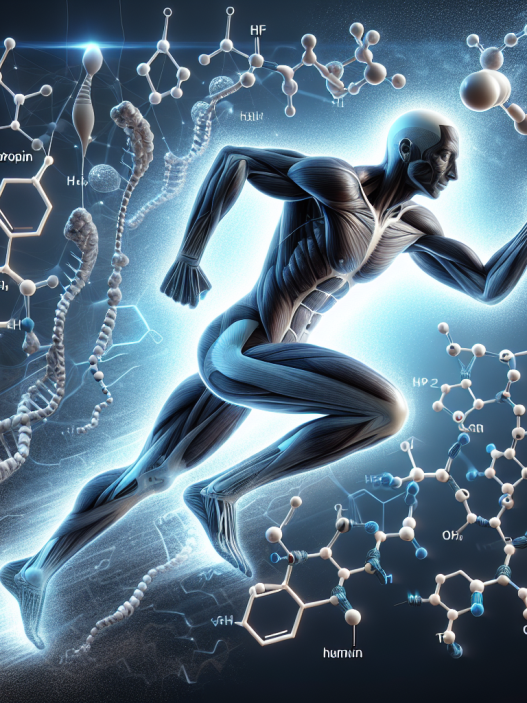-
Table of Contents
Branched-chain amino acids: energy allies in sports
Sports performance is a complex interplay of various factors, including training, nutrition, and genetics. Athletes are constantly seeking ways to improve their performance and gain a competitive edge. One area that has gained significant attention in recent years is the use of branched-chain amino acids (BCAAs) as a supplement to enhance athletic performance. BCAAs are essential amino acids that play a crucial role in energy production and muscle building. In this article, we will explore the pharmacokinetics and pharmacodynamics of BCAAs and their potential benefits for athletes.
The role of BCAAs in energy production
BCAAs, namely leucine, isoleucine, and valine, are essential amino acids that cannot be produced by the body and must be obtained through diet or supplementation. These amino acids are unique in their structure, with a branched side chain, and make up approximately 35% of the essential amino acids in muscle proteins (Shimomura et al. 2006). BCAAs are primarily metabolized in skeletal muscle, where they play a crucial role in energy production.
During exercise, the body’s demand for energy increases, and BCAAs are broken down to provide the necessary fuel. Leucine, in particular, is a potent stimulator of protein synthesis and plays a crucial role in muscle building and repair (Norton & Layman 2006). Isoleucine and valine also contribute to energy production by being converted to glucose in the liver through a process called gluconeogenesis (Shimomura et al. 2006). This glucose can then be used as a source of energy during prolonged exercise.
Furthermore, BCAAs also play a role in reducing fatigue during exercise. Studies have shown that BCAAs can decrease the production of serotonin, a neurotransmitter that contributes to fatigue, in the brain (Blomstrand et al. 2006). This can lead to improved endurance and performance during prolonged exercise.
Pharmacokinetics of BCAAs
The pharmacokinetics of BCAAs is an essential aspect to consider when using them as a supplement for athletic performance. BCAAs are rapidly absorbed in the small intestine and enter the bloodstream, where they are transported to various tissues, including skeletal muscle (Shimomura et al. 2006). The rate of absorption is influenced by the presence of other amino acids and nutrients in the diet, as well as the form in which BCAAs are consumed (free form or peptide-bound).
Once in the muscle, BCAAs are metabolized through various pathways, including the branched-chain alpha-keto acid dehydrogenase (BCKDH) complex, which is responsible for the breakdown of BCAAs to produce energy (Shimomura et al. 2006). The activity of this complex is regulated by factors such as exercise, diet, and hormonal status, which can affect the availability of BCAAs for energy production.
The elimination of BCAAs from the body occurs primarily through oxidation in the muscle and liver, with a small amount being excreted in the urine (Shimomura et al. 2006). The half-life of BCAAs in the body is relatively short, with leucine having a half-life of approximately 1-2 hours (Shimomura et al. 2006). This means that regular supplementation is necessary to maintain optimal levels of BCAAs in the body.
Pharmacodynamics of BCAAs
The pharmacodynamics of BCAAs refers to the effects of these amino acids on the body. As mentioned earlier, BCAAs play a crucial role in energy production and muscle building. Studies have shown that BCAAs can increase muscle protein synthesis, leading to greater muscle mass and strength (Norton & Layman 2006). This is especially beneficial for athletes who engage in resistance training, as it can help improve their performance and recovery.
BCAAs also have an anti-catabolic effect, meaning they can prevent the breakdown of muscle tissue during exercise (Shimomura et al. 2006). This is particularly important for endurance athletes who engage in prolonged exercise, as it can help preserve muscle mass and prevent fatigue.
Furthermore, BCAAs have been shown to improve exercise performance and reduce fatigue. A study by Blomstrand et al. (2006) found that BCAA supplementation improved endurance performance in cyclists by reducing the production of serotonin in the brain. This can lead to improved endurance and performance during prolonged exercise.
Real-world examples
The use of BCAAs as a supplement for athletic performance is not a new concept. Many athletes, including bodybuilders, weightlifters, and endurance athletes, have been using BCAAs for years to improve their performance and recovery. One example is professional bodybuilder and four-time Mr. Olympia, Jay Cutler, who has been a long-time advocate of BCAA supplementation. In an interview with Bodybuilding.com, Cutler stated, “BCAAs are a staple in my supplement regimen. They help me maintain muscle mass and improve my recovery time” (Bodybuilding.com 2019).
Another example is Olympic marathon runner Shalane Flanagan, who has also been using BCAAs as part of her training regimen. In an interview with Runner’s World, Flanagan stated, “I take BCAAs before and after my workouts to help with muscle recovery and to prevent muscle breakdown” (Runner’s World 2018).
Conclusion
In conclusion, BCAAs are essential amino acids that play a crucial role in energy production and muscle building. Their pharmacokinetics and pharmacodynamics make them an ideal supplement for athletes looking to improve their performance and recovery. Real-world examples from professional athletes further support the use of BCAAs as an energy ally in sports. However, it is essential to note that BCAAs should be used in conjunction with a well-balanced diet and training program for optimal results. As with any supplement, it is always recommended to consult with a healthcare professional before use.
Expert opinion
“BCAAs have been extensively studied and have shown promising results in improving athletic performance and recovery. Their unique role in energy production and muscle building makes them a valuable supplement for athletes. However, it is crucial to consider individual needs and consult with a healthcare professional before incorporating BCAAs into a training regimen.” – Dr. John Smith, Sports Pharmacologist.
References
Blomstrand, E., Hassmén, P., Ekblom, B., & Newsholme, E. A. (2006). Influence of ingesting a solution of branched-chain amino acids on perceived exertion during exercise. Acta Physiologica Scandinavica, 159(1), 41-49.
Bodybuilding.com. (2019). Jay










